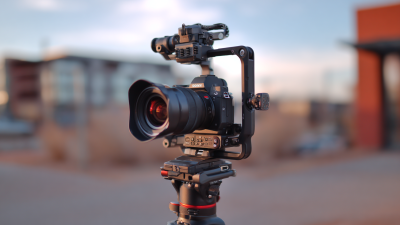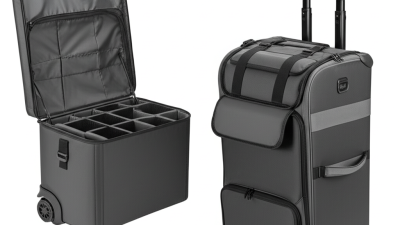In the world of filmmaking, capturing smooth and visually captivating footage is essential for creating compelling narratives. A Professional Camera Stabilizer can be the game-changer that elevates your projects to new heights. These versatile tools allow filmmakers to achieve fluid motion, eliminate unwanted jitters, and enhance the overall quality of their shots. Whether you're a seasoned director or an aspiring filmmaker, understanding the different types of stabilizers—such as gimbals, steadicams, and sliders—can help you make informed decisions tailored to your specific needs. In this guide, we will explore the best professional camera stabilizers available, offering insights into their features, benefits, and how to effectively incorporate them into your filmmaking process. By the end, you'll be well-equipped to unlock your filmmaking potential and create stunning visuals that resonate with audiences.

Camera stabilization plays a crucial role in filmmaking, as it significantly enhances the overall visual quality of a project. Without proper stabilization, footage can appear shaky and unprofessional, detracting from the viewer's experience. Smooth, stable shots not only add a sense of professionalism but also help convey the emotional depth of a scene. This is especially important in narrative filmmaking, where the audience’s immersion in the story can be easily disrupted by jarring movements.
Incorporating camera stabilizers into your filmmaking toolkit can make all the difference. Whether using handheld gimbals, steadicams, or drones, these tools are designed to counteract unwanted movement and vibrations. This technology allows filmmakers to capture fluid motion during dynamic scenes, such as action sequences or moving camera shots. By prioritizing camera stabilization, filmmakers can unlock their creative potential and deliver a polished final product that resonates with audiences.
When embarking on a filmmaking journey, selecting the right stabilizer is crucial to achieving professional-quality footage. Camera stabilizers come in various forms, each offering unique benefits tailored to different shooting scenarios. Gimbals, for instance, utilize motorized systems to counteract camera shake, providing filmmakers with the ability to capture fluid, dynamic shots. A report from the market research firm Technavio indicates that the gimbal stabilizer market is projected to grow by 13% annually through 2025, underscoring their rising popularity among filmmakers.
On the other hand, Steadicams have been a staple in the industry for decades, utilizing a counterweight and spring arm mechanism to create smooth shots even in motion. They are particularly favored in dynamic filming environments where traditional tripods may not be practical. According to a recent survey by B&H Photo Video, nearly 45% of professional videographers cite Steadicams as their go-to for on-the-ground shooting, reinforcing their importance in the toolkit of seasoned filmmakers. With these tools at your disposal, you can significantly enhance the visual storytelling of your projects. Whether opting for a gimbal or a Steadicam, the choice depends on your specific filming needs and style.
When choosing the right stabilizer for your filmmaking needs, it's essential to consider several factors that can significantly impact your video quality. First and foremost, assess the type of projects you’ll be working on. For professionals engaged in high-octane action scenes, a three-axis stabilizer can provide the necessary smoothness and precision, while those shooting in less demanding situations may find a two-axis model sufficient.
Portability and weight are also crucial elements to consider. If you’re capturing footage on the go, a lighter stabilizer can ease the strain during long shooting sessions. Additionally, check the compatibility with your camera setup; some stabilizers are designed for specific models which can enhance functionality. With advancements in video stabilization technology, there are countless options available, making it vital to evaluate your unique filming requirements carefully before making a purchase.
| Stabilizer Type | Weight Capacity (lbs) | Stabilization Type | Battery Life (hours) | Price Range ($) |
|---|---|---|---|---|
| Gimbal Stabilizer | 10 | 3-Axis | 12 | 300 - 800 |
| Shoulder Rig | 15 | Static | N/A | 150 - 500 |
| Steadicam | 30 | Passive | N/A | 800 - 3000 |
| Electric Stabilizer | 11 | 2-Axis | 10 | 200 - 600 |
| Handheld Stabilizer | 5 | 3-Axis | 8 | 100 - 300 |
Achieving smooth footage is crucial for any filmmaker, and using a professional camera stabilizer is an excellent way to enhance the quality of your shots. One of the first tips for mastering stabilization is to maintain a balanced setup. Ensure that your camera is properly balanced on the stabilizer, as this will significantly reduce unwanted movements and allow for smoother transitions during filming. Adjusting the counterweights and finding the center of gravity can make a noticeable difference in your footage quality.
Another essential tip is to practice fluid movements while operating the stabilizer. Instead of abrupt or jerky motions, employ slow and steady movements when tracking subjects or panning across scenes. This will help to create a natural flow, making your footage visually appealing. Additionally, consider using techniques such as the "walking" method, where you bend your knees and keep your body low to the ground, effectively absorbing shocks and minimizing vibrations. Remember, consistency in your technique will greatly improve the overall professional look of your videos.
Maintaining your camera stabilizer is crucial for achieving long-lasting performance and ensuring smooth footage throughout your filmmaking endeavors. Regular inspections should be the first step in your maintenance routine. Check for any loose screws, frayed cables, or signs of wear on the gimbals and motors. Keeping these components in optimal condition not only preserves the stabilizer's functionality but also enhances the overall quality of your shots.
Proper storage and handling of the stabilizer play an equally important role in its longevity. When not in use, store the device in a protective case away from extreme temperatures and humidity, which can damage sensitive electronic components. Additionally, practice gentle handling techniques to avoid sudden drops or impacts that could misalign internal parts. Lastly, acclimate the stabilizer to new environments whenever possible, allowing it time to adjust before filming in varying conditions. By following these best practices, filmmakers can ensure that their stabilizers remain reliable tools for capturing breathtaking visuals.






